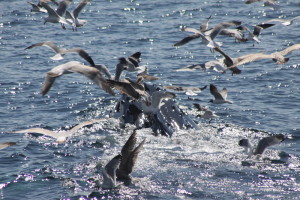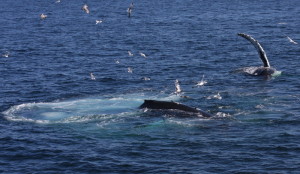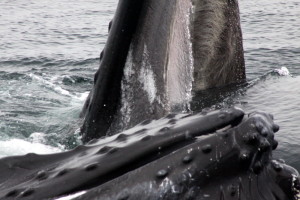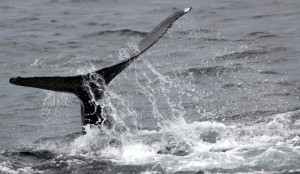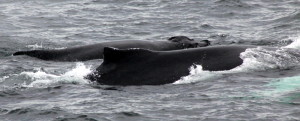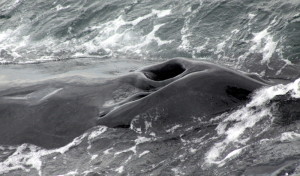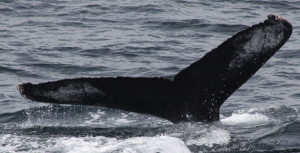Naturalist Notebook – May 10 to May 16
On May 10th we left the dock under clearing skies and with a 3-4 foot swell beneath us. After a quiet trip out to Stellwagen Bank, the Southwest corner of the bank came suddenly alive with humpbacks, Atlantic white-sided dolphins, and a whole slew of birds.
Pisces and her calf appeared on the scene and made their way towards the feeding activity, accompanied by two escort humpbacks. Mother and calves sometimes find themselves accompanied by “escort” animals. While initial hypotheses suggested that this might be a way for males to ingratiate themselves to females before the next season begins, this is probably not the case as females are just as likely to be escorts.
The feeding activities, including kick feeding, bubble clouds, and bubble columns could be seen in all directions. Putter, a large, 19 year old male repeatedly slapped his huge flukes on the surface of the water in order to scare and confuse the fish below.
After the crazy bird activity the day before, we were surprised that there were very few gannets taking advantage of the food stirred up to the surface by feeding whales today, May 11; however, numerous laughing and herring gulls swooped down and plucked up their fill of fish being pushed up by the hungry humpbacks. This weekend the Dolphin Fleet got a chance to play a part in the Audubon Bird-a-thon conducted from May 10 – 12. It is a 24-hour birding competition which also serves as a fundraiser for Audubon, and is also the biggest birdwatching competition in the world! We had teams from three different Mass Audubon sanctuaries on the Dolphin IX throughout the day. Collectively, they spotted great black-backed, herring, ring-billed and laughing gulls, common, roseate, black, and least terns, common and red-throated loons, brant, white-winged and black scoters, eider ducks, red-breasted merganssers, double-crested cormorants, Northern gannets, Manx shearwaters, parasitic jaegers, dunlin, Northern rough-winged swallows and even a Peregrine falcoln!
Just goes to show how much is out there if we keep our eyes peeled!
May 12 was sunny, warm, and calm, and once again, huge bird gathering led us to feeding humpbacks in the morning. We counted at least seventeen humpbacks within a 3/4 mile radius, all chowing down. We could even see small sand eels within the bubble nets before they were swallowed whole by the hungry humpbacks.
After about a half an hour, the groups dispersed and started traveling west, taking intermittent gulps of food while on the run!
This was an active day for humpback calves, with Rapier’s calf getting everyone very excited on the morning trip. This little whale was imitating its mother by blowing small bubble clouds. It then started to breach repeatedly in between bubble bursts!
In the afternoon, the wind picked up from the west, but we still had plenty of calf action out on Stellwagen Bank. Pisces and her calf approached the boat, and the calf spent a lot of time rolling, flipper slapping, and swimming in circles around the Dolphin IX.
Today, one of our naturalists also observed a lot of lions mane jellies floating about near the whales. These sometimes very large invertebrates are only found in cold waters. We’re hoping that they stay far away from the beach when it gets warm enough for a swim!
May 13 was another flat calm morning and as we headed out to the Southwest corner of Stellwagen Bank, we could see black dots and white water on the horizon from three to five miles out! At that point, seeing dozens of humpback whales scattered across our entire field of view we knew we were in for a great trip! The white water seen from a distance was the result of bubble clouds, which these whales use to trap and corral their prey.
Using data from tags, scientists have found that humpbacks use two different styles of bubble feeding. The first, technique, the “upward spiral”, uses only one step, creating a continuous stream of bubbles around a school of fish while the whale ascends.
The second style, the “double loop”, uses multiple steps: The whale blows bubbles in a circle, then kicks its tail, then does another capture loop to trapped the fish stunned by the kick. Amazingly, scientists found that the humpbacks were very consistent in the depth at which the first loop started. It is almost always around 30 meters.
In the morning, we had a group of five to six lunge feeding humpbacks with some of the most spectacular aerial lunges the naturalist had seen in years!
Everywhere we looked, the sand eels were so thick that we felt like we were sitting in fish stew. Everywhere we looked there were humpback mouths agape, revealing hundreds of the baleen plates which hang from their upper jaw, allowing them to strain food from water.
It wasn’t just the humpbacks that were taking advantage of this bounty. There were also at least 20 Minke whales in the vicinity, with many many more on the horizon. Our first mate described the scene has having more Minke whales than he had ever seen at one time. Though surface feeding behavior of Minkes is less dramatic than that of the humpback, we did manage to catch a glimpse of a few surface lunges from these smaller whales.
By the afternoon, the wind had picked up and we rocked and rolled on our way back out to Stellwagen. The whales had spread out, but we had two mother and calf pairs, including Rapier and Basmati and their respective calves.
Gray skies and a gently northeasterly breeze accompanied us to Stellwagen Bank on May 14th. Here, we were thrilled to see Anchor and her new calf next to Basmati and her calf, Tongs, and an unknown humpback.
As we got closer, the three pairs split up, but as we approached, we noticed that Anchor’s calf was also accompanied by a small group of Atlantic white-sided dolphins. In the photo above, you can see the small dorsal fin of a dolphin sticking up next to the calf’s head. Even at only a few months old, these humpback calves are at least twice the length of these full-grown dolphins.
Leaving this area, we ventured on to find Rapier kickfeeding away, and we were amused to see her calf mimicking the way its mother was smacking the surface with her tail.
Humpback whale calves take up to a year to wean, so this whale wasn’t feeding; however, we often see small humpbacks imitating their mothers, practicing behaviors that they will need as adults. Rapier was definitely feeding, as she needs to restore her energy reserves after a winter with no feed. She appeared periodically at the surface with a mouthful of food.
When we looked behind us, we were pleased to see that the group of dolphins had followed us towards the feeding whales! No surprise, as these two species of cetacean have similar diets, despite their size discrepency.
Trying to see as many humpbacks as possible, we moved on to a group of three humpbacks, Snare, Division and Tunguska. Upon closer inspection, we noticed that Division and Tunguska were more closely associated, leaving our naturalist to wonder those two were cooperatively feeding and Snare was just occasionally taking advantage of their efforts. The tagging studies described above have allowed scientists to witness these types of interactions, where opportunistic humpbacks will sometimes lurk on the sidelines while other whales do all of the work, sneaking in to grab a mouthful of fish from a bubble cloud!
On May 15th we continued our streak of finding active, feeding whales on the Southwest corner of Stellwagen Bank. We observed some huge bubble nets consisting of at least 7-8 animals, and if we looked closely, we could see the small, frantic silhouettes of fish against the bubble backdrop.
Basmati and her calf were especially active, with her little one breaching every now and again. Dolphins joined the scene once more and did some leaping themselves!
One close encounter with an unidentifed humpback left us not only mystified as to the whale’s identity, but also wondering what that whale would do next. This whale would approach the boat, disappear for a few minutes, only to reappear in a totally unpredictable spot after waiting and waiting…
We were also lucky to identify Mars’ 2009 calf. Now that this young whale has been documented after having separated from its mother at the end of its first year, it will be eligible for a name and to be entered into the humpback whale catalog that scientists across the globe use to keep track of these populations.






